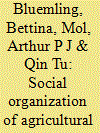|
|
|
Sort Order |
|
|
|
Items / Page
|
|
|
|
|
|
|
| Srl | Item |
| 1 |
ID:
126476


|
|
|
|
|
| Publication |
2013.
|
| Summary/Abstract |
Under the dual pressures of an energy crisis and rising greenhouse gas emissions, biomass energy development and utilisation has become part of the national energy strategy in China. The last decade has witnessed a strong promotion of both centralised and decentralised bio-energy systems in rural China. The government seems to have a strong preference for centralised (village-based) bio-energy systems in recent years. However, these government-driven systems have not worked without difficulties, particularly regarding economic and technological viability and maintenance. Studies on the advantages and disadvantages of decentralised and centralised bio-energy systems are rare. This study aims to shed light on the performances of these two systems in terms of social, economic and environmental effects. Through interviewing local officials and village leaders and surveying farmers in 12 villages in Shandong Province, it was found that bio-energy systems should be selected based on the local circumstances. The diversity of the local natural, economic and social situations determines the size, place, technology and organisational model of the bio-energy system.
|
|
|
|
|
|
|
|
|
|
|
|
|
|
|
|
| 2 |
ID:
126474


|
|
|
|
|
| Publication |
2013.
|
| Summary/Abstract |
Small scale, decentralised electricity generation at village level, based on locally available biomass, is a promising solution for providing electricity access in remote rural areas, as it can supply villages with an independent, reliable, high quality and environmentally friendly energy source. However, despite such systems' technological feasibility, they are often discontinued. Research so far has not studied the reasons for discontinuation. This article analyses a case of biomass based gasification in India, by studying the type of goods the village system provides, and the distribution of benefits within the system. In this case, the infrastructural and social system provide electricity as a "club good". Given fluctuating numbers of service users, the club faced the decision to either expand the system to new members, or to reduce the services provided. The focus on the village community hampered the extension of "the club". A reduction in the quality and quantity of services however decreased the comfort provided by the system. The system faced what here is called a "club dilemma". To avoid the "club dilemma" and for a sustained energy provision, policy needs to find means to secure feedstock, i.e. by the means of subsidies or collaboration with agricultural departments.
|
|
|
|
|
|
|
|
|
|
|
|
|
|
|
|
| 3 |
ID:
126473


|
|
|
|
|
| Publication |
2013.
|
| Summary/Abstract |
While for wind, solar energy or hydropower, energy supply happens directly from the source to the wind wheels, hydropower turbines or solar panels, in the case of biogas, energy production cannot directly take from the energy source, organic matter, but depends on the institutional structures and farmers' practices involved for making energy available. With the production of bioenergy in rural areas, practices within agriculture are transformed, requiring new ways of organizing production processes. Research has left the question largely unanswered of how agricultural biogas production and use are - and can best be - organized within rural society. Which kinds of social organization exist, how are these embedded in existing agricultural institutions and practices, and how do these systems function? Under which conditions may the different kinds of social organization of biogas production and use work sustainably? This introduction article to the Special Issue "The social organization of agricultural biogas production and use" presents a framework for analysing the different kinds of social organization of biogas production and use presented hereafter. Analysis parameters are the supply network, distribution network, distribution of benefits, social boundaries of the system (accessibility) and scale. Using these parameters, the Special Issue articles are outlined.
|
|
|
|
|
|
|
|
|
|
|
|
|
|
|
|
| 4 |
ID:
118842


|
|
|
|
|
| Publication |
2013.
|
| Summary/Abstract |
Households in rural China rely heavily on low quality fuels which results in reduced quality of life and environmental degradation. This study assesses the comparative contribution of household scale biogas installations to the broad set of sustainability objectives in the Chinese biogas policy framework, which targets household budget, fuel collection workload, forest degradation, indoor air quality and health, renewable energy supply, and climate change. A household survey was used to determine how biogas affected consumption levels of crop residues, fuel wood, coal, LPG, and electricity. Biogas users were found to reduce consumption of biomass fuels but not coal. Although LPG is not a highly commonly used fuel in rural China, biogas users nearly cease to use it altogether. A big reduction in fuel wood consumption results in strongly reduced workload and forest degradation. Although household scale biogas has alleviated all sustainability issues targeted by Chinese policies, low quality fuel use remains abundant, even in households using biogas. Continued promotion of the construction of biogas installations is advisable, but additional policies are needed to ensure higher quality heating energy supply and cleaner uses of biomass fuels.
|
|
|
|
|
|
|
|
|
|
|
|
|
|
|
|
| 5 |
ID:
126475


|
|
|
|
|
| Publication |
2013.
|
| Summary/Abstract |
The Chinese government since 1995 has carried out programs for the construction of household biogas digesters in the Chinese countryside. Despite the large governmental spending in the building of household biogas digesters, only 12.16% of the households suitable to produce and use biogas, have built a digester (Li, 2009). This article asks which factors on the household level may be important for the decision whether or not to build a biogas digester. Based on a survey with 1227 households from Guangxi, Hubei, Shandong and Gansu provinces, results of a binary Probit Model show that the governmental promotion of biogas has a significant effect on households' decision. The question arises which households may, if governmental programs were to be running out, be most likely to construct a household biogas digester? The household head's age, the number of household members staying at home, the total household income and the subjective discount rate of the respondents are significant factors in a farm household's decision to build a biogas digester. However, also agro-climatic conditions reveal to be decisive, which is why technical solutions for tackling the low productivity of biogas digesters in cold regions may need to be further considered.
|
|
|
|
|
|
|
|
|
|
|
|
|
|
|
|
|
|
|
|
|